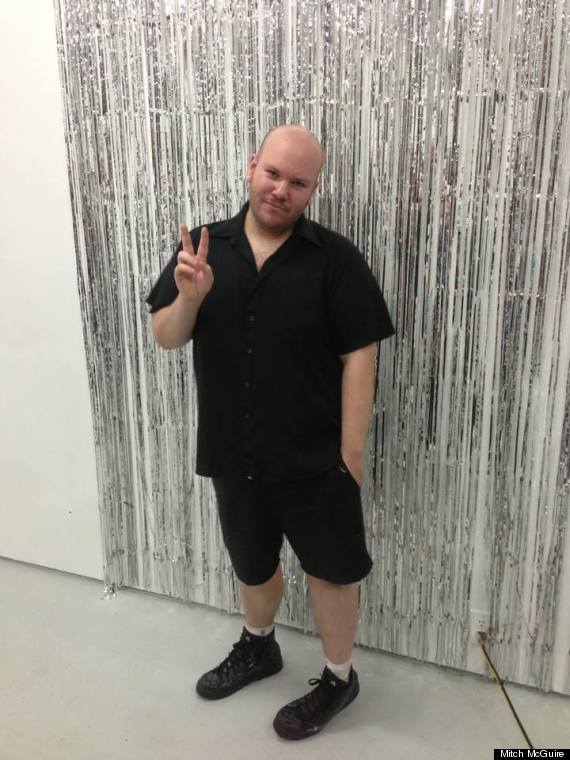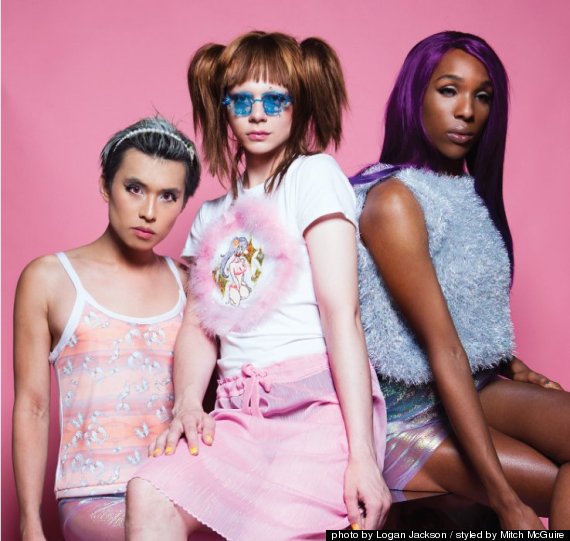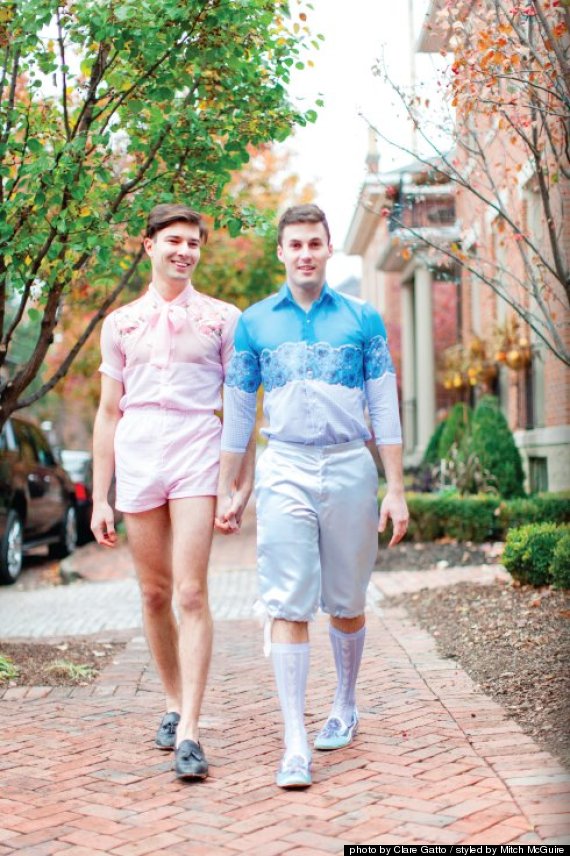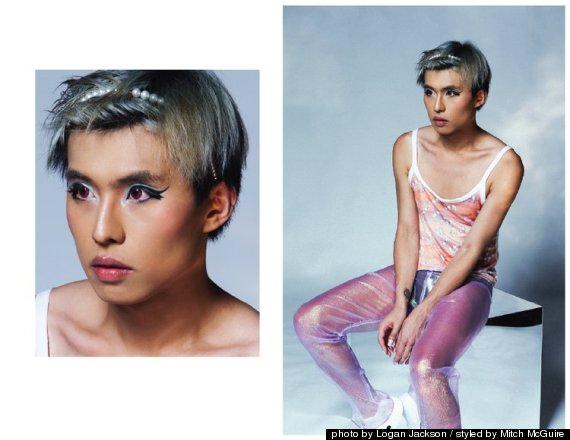
Daily Archives: February 3, 2015
Fabrications: Meet Queer Fashion Designer David Siferd Of GODDESS
Fabrications: Meet Queer Fashion Designer David Siferd Of GODDESS
This is the sixth installment in a miniseries that elevates the work of up-and-coming queer individuals working in the fashion world. Check back at HuffPost Gay Voices regularly to learn more about some of the designers of tomorrow and the way their work in fashion intersects with their queer identity.
David Siferd is a queer fashion designer currently based out of Ohio, having previously lived and worked in New York City. Sold under the street wear label GODDESS, Sieferd’s designs are intended for a range of bodies and identities without limitation by an individual’s sex or gender. The target customer for GODDESS is broad, with Siferd noting that he views fashion as “the perfect platform to help people understand the entire range of human expression and identity.” Check out the interview below.

The Huffington Post: What has your journey as a queer artist and fashion designer entailed?
David Siferd: When I was in the third grade, I moved to a new school and told all the kids that I transferred from “fashion school” where I was kicked out for wearing plaid. As I grew older, I was always drawn to the world of fashion: enticing and glamorous and unlike anything I experienced in my small hometown in Ohio. Fashion seemed like a way for me to escape the pressures and anxieties of growing up. In middle school I became determined to be a fashion designer. Eventually I graduated high school and studied fashion design in college, launching my own label GODDESS after interning with Gerlan Jeans while finishing my degree.
Where have your designs appeared?
My designs for GODDESS have appeared in a number of media outlets, from BULLETT Media, LUTEFISK and GRAPE Magazine to Subjekt Magasin, Mask Magazine and The Cool Hour. My summer 2014 collection sold at the boutiques VFILES in New York and GR8 in Tokyo. Interestingly, several of my designs were used in an artwork by Bjarne Melgaard in 2013 as well.

All items produced by GODDESS are unisex. Why do you consider this to be important?
Unisex is very important to me. I don’t see clothing as only for a male or female-[identified individuals]. I think if someone likes something, they should be free to wear it regardless of their sex or gender. I think fashion is the perfect platform to help people understand the entire range of human expression and identity and, if I can help people be open to new things that way, I will feel I’ve made a positive impact.

You explicitly target queer people with your designs. Why is it important to you to create clothing for the LGBT community?
When I design, I try not to think about whether the person who buys the product and wears it identifies as male or female or trans or anything else. I simply want to create interesting designs that anyone might be interested in wearing. Certain designers and brands have an incredibly narrow and specific target customer in mind, but what’s more interesting to me is when people subvert the intentions of companies. Being appropriate is the most boring and innocuous thing, in my opinion, so playing with things like gender and class and trying to make people think about these things is very exciting to me. If my designs appeal to LGBT people, that’s awesome, but it’s just as interesting to me if I see someone I would never expect wearing my designs.

I think many people are starting to become aware of the huge range of personal expression and fashion designers, in particular, are very perceptive of the ideas of identity that people hold today. Fashion has been increasingly inclusive since its earliest days servicing a very small number of very rich women and if fashion runs on trends, it only makes sense that fashion will continue to expand its reach into the LGBT community.
Where do you draw inspiration for your work? What is your concept?
Each season has a different concept or inspiration behind it. I’m often inspired by certain people — friends or unique people — and then create a world for them to live in. One season the concept was of genderless, anime-esque angels, and another season was inspired by high-maintenance femme bros. Other times my inspirations are more abstract or simply guided by garment design. Taking a different approach at different times keeps my work fun and exciting to me.
What does it mean to you to be a queer designer? How does your queer identity intersect with your work?
Fashion has always gone hand in hand with being gay in my mind. Growing up, I somehow was aware that fashion attracted interesting, unique people, and I always imagined that becoming a fashion designer was kind of like joining the gay circus in a way. Even though I’ve matured and understand much more of the complexities of queer life and the fashion world, being queer is so much a part of me that it’s impossible to divorce that fact from my work.
What’s next for GODDESS? Where do you see the brand going?
2015 is a very exciting year for GODDESS! I can’t reveal too much yet but I have a lot of interesting surprises coming soon and I’m really looking forward to working with more talented stylists, photographers and models to help realize my vision.
Want to see more from GODDESS? Head here to check out the designer’s website. Missed the previous installments in this miniseries? Check out the slideshow below.
The Guardian: HRC’s All God’s Children Campaign Spreads LGBT Equality in the South
The Guardian: HRC’s All God’s Children Campaign Spreads LGBT Equality in the South

Last week, The Guardian featured HRC’s All God’s Children campaign as a leader in achieving LGBT equality in the South.
HRC.org
Iowa Couple Wins Lawsuit Against Wedding Venue That Discriminated Against Them
Iowa Couple Wins Lawsuit Against Wedding Venue That Discriminated Against Them
Iowa man Lee Stafford and his fiancé, Jared, who were turned away from a Grimes, Iowa wedding venue because they’re gay reached a settlement two years after Stafford levied a lawsuit at the venue for discrimination reports KCCI News. The incident occurred two years ago when the couple approached Betty Odgaard and her husband, the owners of Gortz Haus where the couple hoped to wed, to host their wedding there. The Mennonite couple refused them citing that the marriage conflicted with their personal religious beliefs. Stafford then pursued the case with the Iowa Civl Rights Commission. Tom Conley with the Iowa Civil Rights Commission affirmed that Iowa law states that commercial enterprises cannot discriminate against patrons.
The settlement included paying $2,500 to both Lee and Jared along with an agreement from the owners of Gortz Haus to not discriminate in the future. However, the owners of Gortz Haus have since closed the venue to all couples and no longer offer weddings or receptions for straight or gay couples. The Haus couple states weddings were a large part of their business but Gortz Haus still offers other services. The Odgaard’s still say they stand by their convictions and faith after the results of the settlement.
Anthony Costello
LGBT Sport Club : Runners & Figure Skaters – Stories Of Triumph And Transformation
LGBT Sport Club : Runners & Figure Skaters – Stories Of Triumph And Transformation
LGBT Sport Club : Runners & Figure Skaters – Stories Of Triumph And Transformation View more videos like this: www.youtube.com/channel/UCt5MKSekMa9Rcl60HpXlasg …
THISSSSSS FRIDAY = YOUR FAVORITE FRIDAY MOVE + #ALLBLACKEVERYTHING EDITION!!!! —- WE HEAR THAT THEY'RE CALLIN THIS THE SEXY ALL BLACK WINTER PARTY FOR 2015!!!! —- WE TURNING UP FOR ALL AQUARIUS!! E/B FREE BEFORE 12AM!!!! PLUS THOSE $5 #CIROC SHOTS BEF

WATCH: A Bacon-Wrapped Shrimp Comes Out on The Daily Show
WATCH: A Bacon-Wrapped Shrimp Comes Out on The Daily Show
The ‘hellbound crime wrapped in an abomination’ had an emotional moment with host Jon Stewart.
Neal Broverman
www.advocate.com/comedy/2015/02/03/watch-bacon-wrapped-shrimp-comes-out-daily-show
Born This Way Foundation: Reaching Young People Directly
Born This Way Foundation: Reaching Young People Directly
There has been growing attention lately, from politicians and the media, on charities founded by celebrities that spend more time talking about doing good works than actually doing them. Born This Way Foundation is not one of these.
The foundation has one mission: to make the world a kinder and braver place. It is a simple goal but not an easy task. When Lady Gaga and her mom, Cynthia Germanotta, founded the organization, they did so in the belief that the only way to fulfill this mission was by reaching young people — by understanding what they need to become healthy individuals as well as empowered members of their communities. That’s why Born This Way Foundation has worked to connect, engage, and inspire young people — on the road, in their communities, and online.
As their public filings demonstrate, Cynthia, as president of the organization, draws no salary from Born This Way Foundation. It spends its resources directly on reaching young people, to the tune of over $3 million.
First, there was the Born Brave Bus Tour. Partnering with more than 30 local and national organizations including the National Association of School Psychologists (NASP); the Gay, Lesbian, and Straight Education Network (GLSEN); Active Minds; and Youth Service America, the bus tour provided key infrastructure to connect coalition groups with young people. The bus tour, which attracted over 150,000 participants between 2013 and 2014, was a place where young people could connect with one another as well as learn about important mental- and emotional-health resources in their communities and across the United States. It was a place where they could equip and empower themselves to tackle whatever problems they may be facing and be inspired to be kind and brave ambassadors in their communities.
By meeting young people where they were, the bus tour revealed a major gap in the way we approach ensuring the well-being of our young people. Academic research examines how to improve the mental and social conditions of adolescents, but what is often ignored is the translation of the research into the most effective ways to deliver such services. Traditional mental-health delivery methods that we think are appropriate, like telephone hotlines and self-help books, may not actually be useful or effective for young people. Born This Way Foundation is committed to listening to young people themselves and connecting them with the resources they prefer to use.
Second, to reach young people where they are, the foundation partnered with the University of Nebraska-Lincoln, the National Council for Behavioral Health, and the National Association of School Psychologists to collect data from more than 2,500 young people, via both the bus tour and online, on their views of mental-health services and delivery methods. This information formed the basis of two academic papers (presented at the American Psychological Association’s annual conference in August 2014) exploring the gap between the services that are available and the services young people actually want and are willing to use.
Though valuable, this research can only get us so far. So third, Born This Way Foundation, with input from the diverse teens who make up its Youth Advisory Board, has begun to implement these findings into real resources that young people find accessible and effective. Through its website and social media, they are connecting youth with resources both in their communities and online that young people find valuable and easy to use — meeting them where they are instead of forcing outdated and unused service delivery methods on them.
As detailed in the recently released report “Past & Present: A Report on Impact and Our Strategic Vision for the Future,” Born This Way Foundation is gearing up to tackle these issues with a renewed focus on social and emotional learning and mental wellness. Increasingly, academics, educators, parents, and providers understand that young people’s overall well-being is intricately connected to their ability to cope and thrive socially and emotionally. Over the next year Born This Way Foundation will continue to offer innovative approaches that promote these skills and provide young people with support where, when, and how they need it.
There are barriers here that must be overcome. For instance, many states’ youth mental-health policies limit online or text-messaging help. Thus, advocating for more-efficient service delivery methods (i.e., telehealth, text lines, and online support) across the world must be the next frontier for any organization hoping to truly impact the social and emotional well-being of our youth.
No one action by any one organization or person will make the world kinder or braver. But Born This Way Foundation is determined to work with young people to start making a difference, where and when they need it.
Susan Swearer, Ph.D., is currently the chair of Born This Way Foundation’s Research Advisory Board. She has been a high-school special-education teacher for students with emotional and behavioral disorders and has worked as a licensed professional counselor with children, adolescents, and families in residential treatment, inpatient, and outpatient settings. She is a professor of psychology at the University of Nebraska-Lincoln (UNL) and a licensed psychologist in the state of Nebraska, where she was the director of the Nebraska Internship Consortium in Professional Psychology for seven years. She is currently a supervising psychologist in the Counseling and School Psychology Clinic at UNL and the founder of the Empowerment Initiative.
Watch Rob Gronkowski Read Even More Erotic Fiction About Himself
Watch Rob Gronkowski Read Even More Erotic Fiction About Himself
 “At the end of a row of lockers, I turn a corner and there he is. It’s a giant of a man, a warrior. His muscles ripple in soft light and a splash of water coming from the shower head,” reads New England Patriots’ tight end Rob Gronkowski from the erotic fan fiction story about himself called A Gronking To Remember.
“At the end of a row of lockers, I turn a corner and there he is. It’s a giant of a man, a warrior. His muscles ripple in soft light and a splash of water coming from the shower head,” reads New England Patriots’ tight end Rob Gronkowski from the erotic fan fiction story about himself called A Gronking To Remember.
We got a sneak peek at the meta-reading last week at the Super Bowl Media Day, but now he’s back to finish what he started.
“His buttocks are sublime,” continues Rob. “Gronk has a 6-pack you could wash laundry on. I lick my lips thinking about it.”
They might want to fins someone besides Rob to do the book on tape, however. He’s a bit flat. Good thing that whole football thing seems to be working out for him.
Watch below:
Dan Tracer
Go On A Romantic and Sweet Gay First Date With Music Video 'The Thing I Didn't Know' – WATCH
Go On A Romantic and Sweet Gay First Date With Music Video 'The Thing I Didn't Know' – WATCH
To promote his new book, The Thing I Didn’t Know, author Brent Hartinger had a novel idea to build interest in his latest work: create a song and music video inspired by the book. With the help of musician Brett Avery and filmmaker Jeremy Ward, Hartinger set off on his journey.
Towleroad readers may recall Hartinger’s previous effort, The Geography Club, which was adapted into a feature film. The Thing I Didn’t Know continues to follow that book’s protagonist Russel Middlebrook as he matures into adulthood:
“Russel Middlebrook is twenty-three years old, gay, and living in trendy Seattle, but life isn’t keeping up with the hype. Most of his friends have a direction in life—either ruthlessly pursuing their careers or passionately embracing their own aimlessness. But Russel is stuck in place. All he knows is that crappy jobs, horrible dates, and pointless hook-ups just aren’t cutting it anymore.”
When turned into a song and music video, the end result is romantic and endearing. The video stars Hans Iverson as Russel and Randall Brammer as his beau, Felicks.
Catch a case of the awws, AFTER THE JUMP…
Sean Mandell
